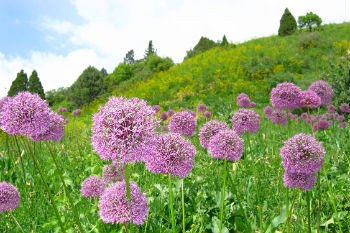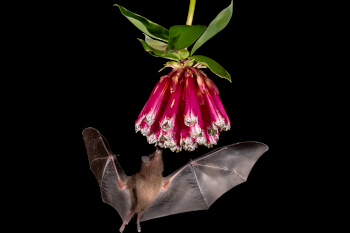Main menu
CEPF is a joint initiative of l’Agence Française de Développement, Conservation International, the European Union, Fondation Hans Wilsdorf, the Global Environment Facility, the Government of Japan and the World Bank.
Visitez le site français コア情報の日本語翻訳を読むOr use Google Translate to translate the English site to your language:
GTranslate
Celebrating International Day of the World’s Indigenous Peoples
Highlighting three CEPF projects supporting Indigenous communities in Peru, Bolivia and Cambodia
09 August 2024
09 August 2024
Indigenous peoples' territories encompass 28% of the surface of the globe and contain 11% of the world’s forests. They are guardians of most of the world’s remaining biodiversity. When their collective rights to lands and territories are protected, biodiversity thrives. Their survival is crucial to the protection of our planet. CEPF grants help Indigenous communities take charge of the conservation of their own ecosystems, helping them gain formal land tenure and rights to manage their ancestral lands and giving them the resources and skills they need to take on the challenge of conserving their natural heritage and find ways of sustainably benefiting from it.
In honor of International Day of the World’s Indigenous Peoples, we're sharing the stories of three CEPF grantees who are working to support Indigenous communities in the Tropical Andes and Indo-Burma Biodiversity Hotspots.
Indigenous Youth Strengthen Community Ties and Livelihoods in Cambodia
Northern Cambodia is home to the Kui people, the largest Indigenous peoples group in the country. Many depend heavily on tapping dipterocarp resin trees for their livelihoods. Pressure from logging, mining and agribusiness, is, however, reducing the number of dipterocarp trees and, therefore, the economic prospects of many Kui people.
The Cambodian Indigenous Youth Association (CIYA) stepped in to work with three local communities to help them to protect their natural resources. In all three villages, youth, particularly Indigenous youth, are caught in a fight between traditional values that prioritize community benefits and natural resource conservation, and modern values that focus more on individual gain. CIYA’s work entailed rebuilding traditional values and engaging youth in all aspects of community life, including livelihood projects.
By the end of the project, three youth groups were created: a savings group, an agricultural group and a patrol group. The formation of these groups contributed to youth mobilization, improved livelihoods and reduced reliance on natural resource extraction. The savings group amassed US$4,000 in capital to be used to support their initiatives, and the agricultural group promoted shared farming, in which youth and elders collaborate. The patrol group brought youth and elders together for regular patrolling to share traditional knowledge of natural resources and protect the community’s forest. A total of 59 men and 17 women received cash benefits, chiefly from community livelihood projects such as pig farming.
Older people reported that they did not fully appreciate the value of younger generations until their youth got more engaged. Meanwhile young participants in the project reported that they previously did not realize the role they could play in the community and now felt proud of their contributions.
Indigenous Peruvian Communities Strengthen Protected-Area Management
Awajún Indigenous communities that live in and around the Chayu Nain Communal Reserve in northeast Peru used CEPF grant funding to strengthen the comanagement of the reserve and improve livelihoods. The project supported updates to three management documents: ECA Chayu Nain’s statute; its operating system; and regulations on the protection and conservation of the natural resources of 11 Indigenous communities neighboring the Chayu Nain Communal Reserve comanaged with the National Service of Protected Areas by the State (SERNANP).
Training provided to 1,151 community members—43% women and 57% men—focused on conservation and the importance of the ecosystem services provided by the reserve. With the support of partner organization Yunkawasi, five young men and women from the Indigenous communities were trained in designing and managing conservation projects. They secured a donation of US$8,000 from the New England Biolabs Foundation for the implementation of a project promoting the breeding of Amazonian fish in the Chiriaco Basin in northeastern Peru, in an Awajún community allied with the Chayu Nain Reserve.
The ECA Chayu Nain also created a craft committee with 34 members (29% men and 71% women). The committee is responsible not only for preserving the craft traditions of the Awajún communities, but also for raising the quality and value of their products. By the time of the project’s completion, a commercial agreement had been established to sell handcrafted goods in a coffee shop in the city of Chachapoyas.
Project Inspires Action Against Illegal Mining in Bolivia
A CEPF-funded project looking at the consequences of illegal gold mining on communities in northwestern Bolivia’s Madidi-Pilón Lajas-Cotapata conservation corridor turned concerning evidence of negative health impacts into positive action.
Wildlife Conservation Society (WCS) in Bolivia led the project, working with three other Bolivian groups dedicated to mitigating the impacts of uncontrolled illegal gold mining in the Tropical Andes Biodiversity Hotspot. Central de Pueblos Indígenas de La Paz (CPILAP), which represents the Indigenous peoples of the Department of La Paz, led the gathering of information on community impacts of gold mining activities in the Beni River Basin and its tributaries. An analysis of hair samples collected in 36 Indigenous communities revealed that more than 75% of the samples taken exceeded the World Health Organization’s maximum threshold for mercury at 1 part per million (ppm). The average mercury concentration of the samples was 3.93 ppm, with the highest being 17.52 ppm.
Using the findings, CPILAP launched a successful outreach campaign that called on local and national government authorities to take action to stop the illegal activities. The municipality of Rurrenabaque, which has jurisdiction over the lower watershed of many rivers where the illegal mining takes place, ordered a halt to the illegal mining. A judge also ordered the installation of control posts to allow the Bolivian police and armed forces to patrol the waterways at risk. The campaign led to proposals by national authorities to reform the country’s outdated mining laws, including controls on the importation of mercury to Bolivia, and a major conference held in September 2023 focused on how to deal with the widespread pollution caused by gold mining in the Bolivian portion of the Tropical Andes Biodiversity Hotspot.









